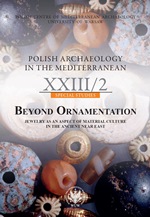Tracing the “Diadem Wearers”: an inQuiry into the meaning of simple-form head adornments from the Chalcolithic and Early Bronze Age in the Near East
Tracing the “Diadem Wearers”: an inQuiry into the meaning of simple-form head adornments from the Chalcolithic and Early Bronze Age in the Near East
Author(s): Zuzanna WygnańskaSubject(s): Archaeology
Published by: Wydawnictwa Uniwersytetu Warszawskiego
Keywords: diadems, headbands, frontlets, Near East, Anatolia, Chalcolithic, EBA, gold and silver jewelry BC, excavated in 2008 at the site of Tell Arbid
Summary/Abstract: Simple-form head adornments made of precious metals appeared in the Near East in the second half of the 4th millennium BC. They consisted of a long narrow band as a rule, but small oval or rhomboidal plates or single leaf-shaped adornments were also in use. Consequently, these ornaments or ‘diadems’, as they are usually referred to, are apt to be interpreted as markers of high status, the interpretation being based mainly on studies of different types of depictions, such as reliefs. The article is focused on the real diadems deriving from graves and hoards. A closer examination of their specific contexts, coupled with ethnographic observations, indicates their frequent use as symbols of elevated position, but also as indications of non-vertical features of individual social identity, such as, for example, affiliation with an ethnic or other social group. Iconographic studies have demonstrated that plain and simple headbands may have indeed been perceived as symbols of power (crowns), whereas frontlets and other forms of diadems not known from depictions could have represented diverse social aspects of the wearer or acted as attributes of rites of passage. The aim of this article is to examine the various uses of simple diadems and to study their differentiated context during the late 4th and 3rd millennium BC in the Near East in order to better understand the meaning of the burials with simple-form diadems.
Journal: Polish Archaeology in the Mediterranean
- Issue Year: 2/2014
- Issue No: XXIII
- Page Range: 85-144
- Page Count: 60
- Language: English

